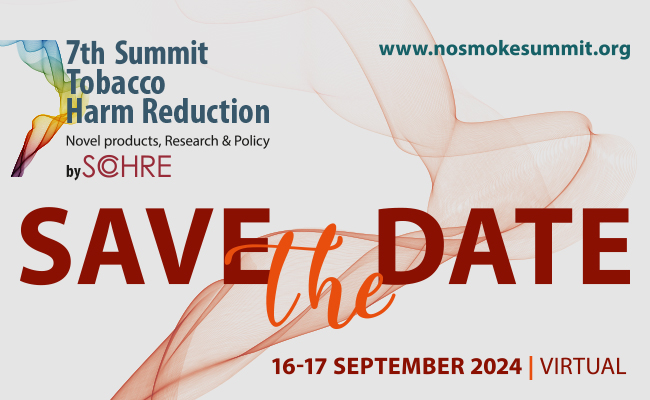There is already enough evidence on e-cigarettes and HTPs, was the conclusion of the session “Health effects of e-cigarettes and heated tobacco products”, chaired by Professor Konstantinos Poulas.
The evidence from both individual studies and “umbrella reviews” shows that e-cigarettes and HTPs are effective on increasing smoking quit rates and that they have no impact on cell physiology; in fact, nicotine alone may even have some beneficial effects. We all need some stimuli for our brain reward system in order to be happy. By educating people about how the reward system works and how to find positive stimuli, we can be more successful in protecting them from the harmful effects of smoking.
Commenting on the subject “At the Top of the Evidence Pyramid – Clinical Evidence on the Effectiveness of E-Cigarettes for Tobacco Cigarette Cessation”, Mrs Renee O’Leary proved wrong those who say that there is not enough evidence on the effects of e-cigarettes. However, she highlighted the importance of the quality of the studies, pointing out that uncritically accepting the results of any single systematic review has risks. This is due to two main problems: i) the subjectiveness of the decisions about which studies to include or to exclude, and ii) the fact that sometimes the methodology is not carried out in a robust way. So, a new form of methodology was set up, called the “umbrella review”, which includes all individual studies, systematic reviews, and meta-analyses that have been carried out. This overview of secondary reviews (OoSR) constitutes a tertiary level of synthesis, where both quality and data are taken into account.
Mrs O’Leary and her team gathered all systematic reviews that had been published on electronic nicotine delivery systems (ENDS) and smoking cessation since the beginning of 2021 up to August 2023; that is, 17 systematic reviews. Among these, five were considered reliable enough, based on robust criteria, and were included in the current, preliminary results, which focused on two endpoints: quit rates and comparative effectiveness of ENDS.
The meta-analysis of 21 RCTs (including 18 longitudinal cohort studies) showed that smoking quit rates ranged between 44% at 6 months and 14% at 12 months. The general quit rate was 10%; this is why we need harm reduction, the speaker pointed out. The cohort studies meta-analysis found no significant difference in quit rates – no improvement, but also no detriment.
The speaker then referred to the comparative effectiveness of ENDS, based on RCT data. When ENDS were compared to behavioural support/no support, one systematic review found that ENDS were 161% significantly more effective. When ENDS were compared to NRTs, 2 systematic reviews found that ENDS were 65% significantly more effective, whereas one review found no significant difference. When ENDS were compared to any sort of treatment in a trial, 2 systematic reviews found that ENDS were 55% significantly more effective. Finally, 2 systematic reviews that compared nicotine ENDS vs. non-nicotine ENDS found that nicotine ENDS were 75% significantly more effective.
Finally, Mrs O’Leary referred to the expected impact of the final results of her team’s analysis, which are to be published at the end of the year. First, this type of analysis may be used as a “one-stop shop” for evidence for policymakers and clinicians, as it includes everything that has been published on the subject. Secondly, it identifies the best quality systematic reviews for researchers and clinicians. Moreover, it puts an end to the spin bias for the tobacco control community; it also points to future research needs for researchers and funders.
At the beginning of his detailed presentation on “Cigarette smoke and Reduced risk products as modifying factors in Non-Alcoholic Fatty Liver Disease progression”, Professor Giovanni Li Volti pointed out that although smoking has been extensively studied as a risk factor for human disease (lung cancer, cardiovascular disease, infertility,) it has not been particularly studied as a modifying factor of existing diseases. However, cigarette smoke may impact on the progression of various diseases, and it may itself cause other risk factors; a well-known study shows that cigarette smoke promotes drug resistance.
Non-alcoholic fatty liver disease (NAFLD) is a clinico-pathologic syndrome encompassing a wide range of fatty liver disease in the absence of significant alcohol intake (2 drinks or fewer daily) and other common causes of steatosis. A survey on adolescent participants in the NHANES study showed that 8.0% of US adolescents (12-19 years old) have elevated ALT levels, a surrogate marker of the disease. Therefore, NAFLD is already present when people start smoking, and combustion products may impact on an already existing disease. NAFLD has a progressive course, starting with macrovascular steatosis and progressing to inflammation, fibrosis, and finally cirrhosis, a very severe form that requires liver transplantation. Oxidative stress is in the centre of NAFLD pathophysiology, and this is why combustion products were suspected to have an impact on the progression of the disease.
The aim of a study carried out by Prof. Volti and his team was to assess the direct impact of nicotine, cigarette, and a tobacco heated product on liver cells (hepatocytes) as a modifying factor for NAFLD progression. The researchers treated hepatocytes with palmitic acid and oleic acid in order to mimic an in vitro model of steatosis―and provoke the disease―and compared various parameters with or without the addition of nicotine, cigarette, and a tobacco heated product. The results of this study, as well as a study carried out on mice, showed that none of the above factors had any impact on the lipidic content inside the cells, on cell viability, on mitochondrial fitness, or on cell polarisation. In fact, nicotine alone may even have had some beneficial effects on mitochondrial function and on lipid metabolism.
In her very interesting speech on “Futuromics: Integrating science in medical practice for health decisions – from nutrition to well-being and addictions”, Professor Manuela Grazina attempted to explain how the brain reward system works and why individuality contributes to health risks and to the outcomes of treatments.
In theory, Prof. Grazina said, if we all avoided alcohol, were physically active, cut down on salt and sugar, didn’t use tobacco products and ate plenty of fruits and vegetables, we could stay healthy and avoid risks. However, individuals get involved in risky behaviours; people are free to make choices, and this is why we have an obligation to educate the public and reduce harm.
The limbic system plays a central role in the brain reward circuitry; it is responsible for our behavioural and emotional responses and it coordinates our impulses, emotions and memories. When the limbic system perceives a pleasure stimulus, dopamine is released, creating a sensation of well-being. But if dopamine levels increase too much, the person may become psychotic; moreover, the excess of adrenaline that is produced is harmful for the heart. These risks are avoided through activation of the prefrontal cortex, which leads to releasing GABA, a molecule that serves as a break.
“We are all looking for a carrot”, Prof. Grazina said; we survive better with pleasure in our life. But too much stimulation may lead to addiction, therefore, we need to control our impulses and be able to make choices that do not put us in danger. Yet, we are not born with this capacity; the prefrontal cortex develops through life, and it matures around the age of 21.
This maturing process is influenced by several factors: genetics, nutrition, sleep, exercise, and social interaction. Genetics dictates in part the efficacy of the reward system and the quantity of dopamine produced. However, this quantity is also influenced by what we eat; a diet poor in protein, interferes with the function of the reward system, which needs aminoacids to produce dopamine and serotonin. This is why these risky behaviours are very much associated with poverty. Sleep quantity also significantly affects the reward system organization and functioning. Sports, music and social interaction are very powerful in stimulating the reward system positively.
If we take measures to increase well-being, reduce stress and anxiety and value the person, we will be more successful in protecting people from the harmful effects of smoking. When someone feels well and valued, there is no need to extra-stimulate the reward system. Therefore, we must train our brain to resist impulses and to find positive stimuli.
Research helps us understand the brain mechanisms and science should be integrated for harm reduction approaches. No political decisions should be taken without scientific support. Laws are crucial to protect minors and the most vulnerable, but they are not enough. Education and culture are the keys to freedom, the key to a better health, Prof. Grazina concluded.








